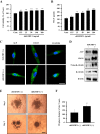Human umbilical cord blood mesenchymal stem cells engineered to overexpress growth factors accelerate outcomes in hair growth
- PMID: 30181702
- PMCID: PMC6115345
- DOI: 10.4196/kjpp.2018.22.5.555
Human umbilical cord blood mesenchymal stem cells engineered to overexpress growth factors accelerate outcomes in hair growth
Abstract
Human umbilical cord blood mesenchymal stem cells (hUCB-MSCs) are used in tissue repair and regeneration; however, the mechanisms involved are not well understood. We investigated the hair growth-promoting effects of hUCB-MSCs treatment to determine whether hUCB-MSCs enhance the promotion of hair growth. Furthermore, we attempted to identify the factors responsible for hair growth. The effects of hUCB-MSCs on hair growth were investigated in vivo, and hUCB-MSCs advanced anagen onset and hair follicle neogeneration. We found that hUCB-MSCs co-culture increased the viability and up-regulated hair induction-related proteins of human dermal papilla cells (hDPCs) in vitro. A growth factor antibody array revealed that secretory factors from hUCB-MSCs are related to hair growth. Insulin-like growth factor binding protein-1 (IGFBP-1) and vascular endothelial growth factor (VEGF) were increased in co-culture medium. Finally, we found that IGFBP-1, through the co-localization of an IGF-1 and IGFBP-1, had positive effects on cell viability; VEGF secretion; expression of alkaline phosphatase (ALP), CD133, and β-catenin; and formation of hDPCs 3D spheroids. Taken together, these data suggest that hUCB-MSCs promote hair growth via a paracrine mechanism.
Keywords: Alopecia; Dermal papilla cell; Hair growth; IGFBP-1; Stem cell; Stem-cell therapy.
Conflict of interest statement
CONFLICTS OF INTEREST: The authors declare no conflicts of interest.
Figures





Similar articles
-
Regenerative medicine strategies for hair growth and regeneration: A narrative review of literature.Regen Ther. 2022 Oct 31;21:527-539. doi: 10.1016/j.reth.2022.10.005. eCollection 2022 Dec. Regen Ther. 2022. PMID: 36382136 Free PMC article. Review.
-
Migration Inhibitory Factor in Conditioned Medium from Human Umbilical Cord Blood-Derived Mesenchymal Stromal Cells Stimulates Hair Growth.Cells. 2020 May 28;9(6):1344. doi: 10.3390/cells9061344. Cells. 2020. PMID: 32481584 Free PMC article. Clinical Trial.
-
Thrombospondin-2 secreted by human umbilical cord blood-derived mesenchymal stem cells promotes chondrogenic differentiation.Stem Cells. 2013 Oct;31(10):2136-48. doi: 10.1002/stem.1471. Stem Cells. 2013. PMID: 23843355
-
Downregulation of Melanoma Cell Adhesion Molecule (MCAM/CD146) Accelerates Cellular Senescence in Human Umbilical Cord Blood-Derived Mesenchymal Stem Cells.Stem Cells Transl Med. 2016 Apr;5(4):427-39. doi: 10.5966/sctm.2015-0109. Epub 2016 Mar 3. Stem Cells Transl Med. 2016. PMID: 26941359 Free PMC article.
-
Human hair follicle-derived mesenchymal stem cells: Isolation, expansion, and differentiation.World J Stem Cells. 2020 Jun 26;12(6):462-470. doi: 10.4252/wjsc.v12.i6.462. World J Stem Cells. 2020. PMID: 32742563 Free PMC article. Review.
Cited by
-
Regenerative medicine strategies for hair growth and regeneration: A narrative review of literature.Regen Ther. 2022 Oct 31;21:527-539. doi: 10.1016/j.reth.2022.10.005. eCollection 2022 Dec. Regen Ther. 2022. PMID: 36382136 Free PMC article. Review.
-
Minoxidil delivered via a stem cell membrane delivery controlled release system promotes hair growth in C57BL/6J mice.Front Bioeng Biotechnol. 2024 Jan 8;11:1331754. doi: 10.3389/fbioe.2023.1331754. eCollection 2023. Front Bioeng Biotechnol. 2024. PMID: 38260729 Free PMC article.
-
Synergistic effects of Rhynchosia nulubilis and Polygonum multiflorum extract combination on cell proliferation via targeting IGFBP-1 & NT-3 and cytotoxicity suppression in testosterone-induced human dermal papilla cells.PLoS One. 2025 May 27;20(5):e0321812. doi: 10.1371/journal.pone.0321812. eCollection 2025. PLoS One. 2025. PMID: 40424268 Free PMC article.
-
Application of extracellular vesicles from mesenchymal stem cells promotes hair growth by regulating human dermal cells and follicles.World J Stem Cells. 2022 Jul 26;14(7):527-538. doi: 10.4252/wjsc.v14.i7.527. World J Stem Cells. 2022. PMID: 36157528 Free PMC article.
-
Stem cell secretome as a mechanism for restoring hair loss due to stress, particularly alopecia areata: narrative review.J Biomed Sci. 2022 Oct 5;29(1):77. doi: 10.1186/s12929-022-00863-6. J Biomed Sci. 2022. PMID: 36199062 Free PMC article. Review.
References
-
- Ferriman D, Gallwey JD. Clinical assessment of body hair growth in women. J Clin Endocrinol Metab. 1961;21:1440–1447. - PubMed
-
- Harada T, Izaki S, Tsutsumi H, Kobayashi M, Kitamura K. Apoptosis of hair follicle cells in the second-degree burn wound unders hypernatremic conditions. Burns. 1998;24:464–469. - PubMed
-
- Leyden J, Dunlap F, Miller B, Winters P, Lebwohl M, Hecker D, Kraus S, Baldwin H, Shalita A, Draelos Z, Markou M, Thiboutot D, Rapaport M, Kang S, Kelly T, Pariser D, Webster G, Hordinsky M, Rietschel R, Katz HI, Terranella L, Best S, Round E, Waldstreicher J. Finasteride in the treatment of men with frontal male pattern hair loss. J Am Acad Dermatol. 1999;40:930–937. - PubMed
-
- Kligman AM. Pathologic dynamics of human hair loss. I. Telogen effuvium. Arch Dermatol. 1961;83:175–198. - PubMed
LinkOut - more resources
Full Text Sources
Other Literature Sources
Research Materials
Miscellaneous

